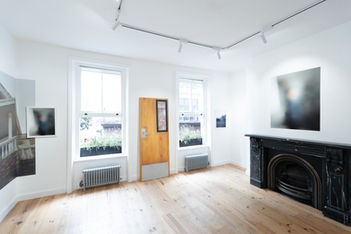

What makes a space legible—and what happens when it isn’t? Room we didn’t build brings together works by Lujane Pagganwala, Maya Silverberg, and Tom Xiangyin Gu, each of whom engages with space not as a container of meaning, but as something unstable, porous, and continually reconstituted through perception, memory, and material gesture. These artists do not construct spaces so much as reveal the unseen architectures—psychic, cultural, and affective—that shape our experience of them.
As with much of Pagganwala’s practice, elements from earlier works reappear in Poldy and the Wagtail (2025)—fragments of materials, gestures, or architecture—carrying with them residues of past installations and layering time within the present. The title draws from her childhood book she reencountered after the spontaneous recollection of a wagtail bird, triggered in conversation with her father. Drawings from the book, along with notes jotted in passing moments are printed on white muslin fabric and dispersed throughout the structure. The result is what she terms Flash Spaces: liminal constellations where physical, remembered, and imagined dimensions fold into one another. Water brought from Karachi acts as a poetic undertone—an invisible tether to a city where the sea is sensed everywhere, through scent, sound, and air. As the installation unfolds over time, the water gradually soaks the muslin fabric, while rust bleeds into the surface. This slow material transformation renders the space itself unstable—always in flux—enacting entanglement not as a fixed concept, but as a process of becoming.
If Pagganwala’s practice renders spatial phenomena through transience and entanglement, Silverberg’s work probes the opposite edge: how images, especially those tied to built interiors and decorative conventions, deceive their surface legibility. Trained in trompe l’œil and informed by a deep engagement with craft, Silverberg constructs layered, perspectival objects that interrogate painting’s oscillation between illusion and material fact. Her works composed from original sculpture, faux finishes, screenprint, and readymade components—simulate and destabilize in the same breath. They expose the seams of representation, calling attention to the ways images are staged, built, and inhabited. In Silverberg’s hands, the image is not an end point but a recursive mechanism—each work folds back into itself, part object, part imitation, part theatre set awaiting occupation.
Gu approaches spatiality through the quiet erosion of photographic memory where his series Failure of Memory emerged from a camera malfunction, which produced blurred, unfocused images of his family home. Images that, rather than being discarded, became central to his inquiry. Drawing on psychoanalytic theory, Gu treats this technical failure not as error but as metaphor: a photographic equivalent of Freud’s screen memory, where distortion becomes a mode of access to the unconscious. Gu explained that the camera is a cruel representation of the world: too honest, too precise, offering no space for doubt. By contrast, the malfunction camera introduced ambiguity, allowing him to explore memory as something unstable, recursive, and emotionally charged. The uninhabited rooms and architectural motifs dissolve into gradients of light and form, evoking the inarticulable nature of recollection. Drawing on psychoanalytic theory, Gu treats this technical failure not as error but as metaphor—a photographic equivalent of Freud’s screen memory, where distortion becomes a mode of access to the unconscious. The uninhabited rooms and architectural motifs dissolve into gradients of light and form, evoking the inarticulable nature of recollection. Photography, in Gu’s practice, is not a vehicle for clarity but a site of atmospheric doubt. His prints function less as representations than as emotional temperatures—measuring what is left behind after vision fails. Like memories that shift with each recall, Gu’s works carry a mournful elasticity, insisting that what matters in the image is not its accuracy, but its persistence.
The exhibition dwells in spatial residue—in echoes, scaffolds, and surfaces that do not resolve into certainty. These are rooms we didn’t build: unstable architectures of affect, illusion, and time.

Room we didn't build: Lujane Pagganwala, Maya Silverberg, Xiangyin Gu
16 July 2025
—
16 August 2025





